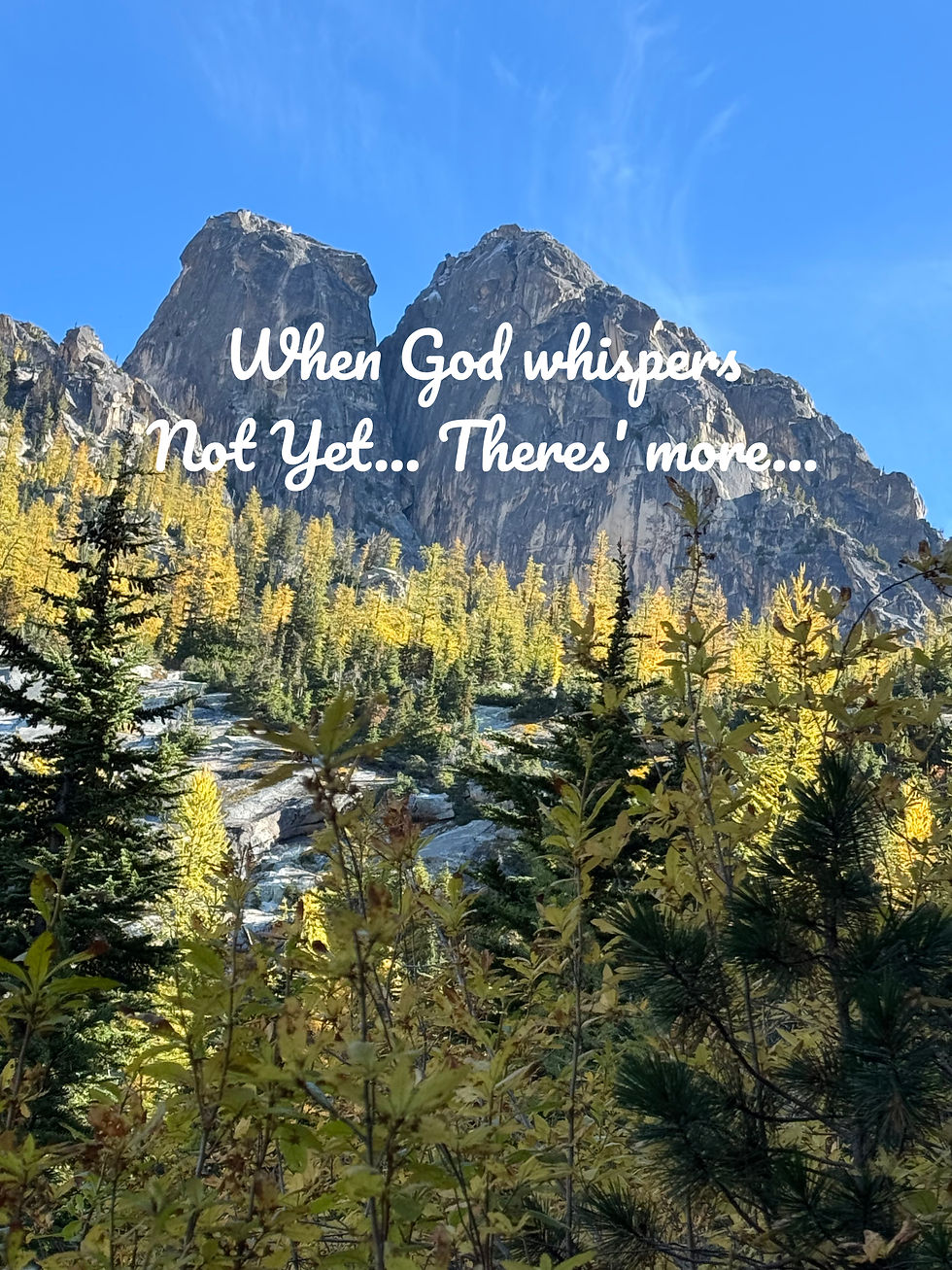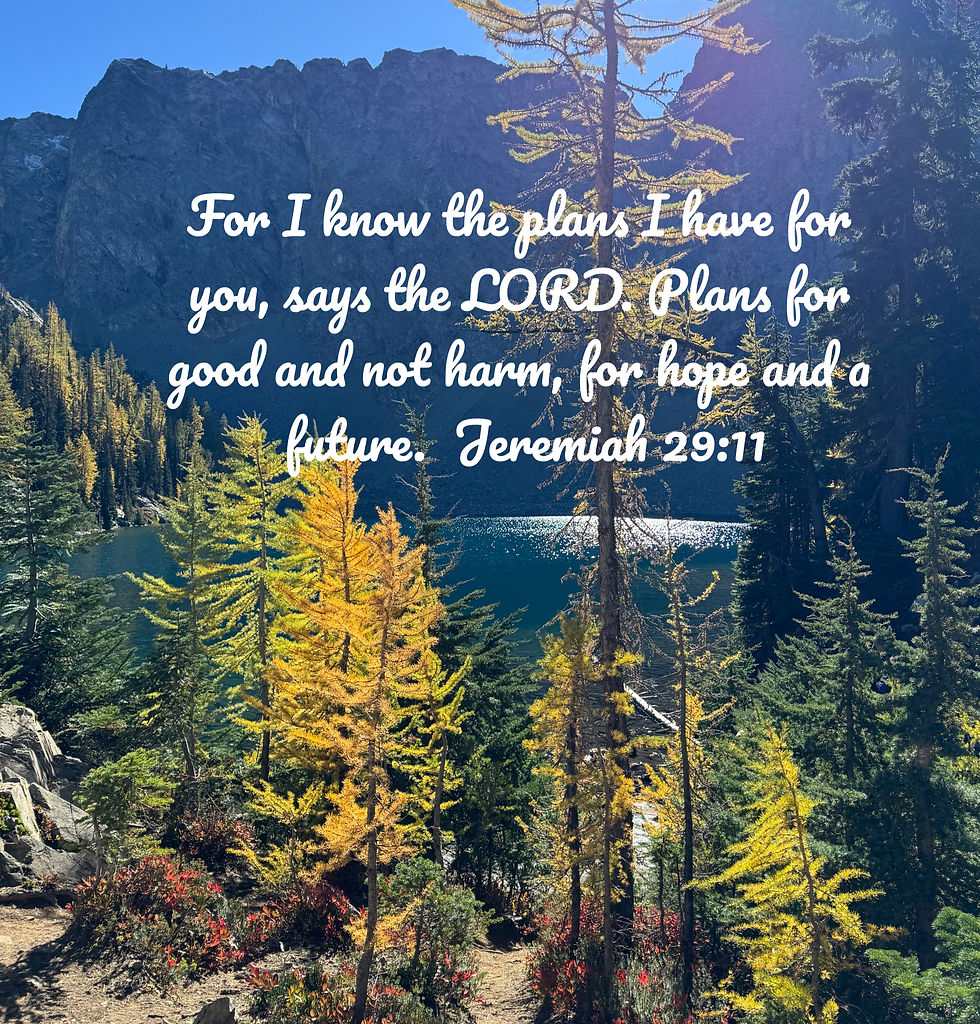Finding Hope in God’s “Not Yet”: Lessons from Larches, Fall Colors, and Faith in the Waiting
- mcnamaraadrienne
- 7 days ago
- 4 min read

A Fall Getaway and a Fresh Perspective
The first weekend of October, we enjoyed a getaway to Winthrop, Washington—one of our favorite little mountain towns. We go there every year and have been doing so for well over a decade, but always in February for snow activities. This was our first time visiting in the fall.We enjoyed horseback riding and walking on the trails that we normally traverse by either cross-country ski or snowshoe, loving the different perspective a new season brings. My favorite part of going during a different time was the fall colors. Winthrop is in the northeastern part of Washington, nestled in the Methow Valley just outside of North Cascades National Park. The dry climate with cool nights is particularly conducive for producing spectacularly bright fall foliage—perfect for a fall reflection on spiritual growth and renewal.

Discovering the Larches
While there, I heard someone mention hiking to see the larches. I had heard about these somewhat rare and seemingly mythical alpine deciduous conifer trees that turn a bright yellow during October. I hadn’t realized that our trip was going to coincide with both the timing and prime location to see them.Not one to miss an opportunity, naturally, we determined to plan our drive home to include a larch-viewing hike—a perfect way to experience God’s beauty in creation and reflect on His promises through nature.
Hiking the North Cascades Highway
The drive home was on the North Cascades Highway—the only access to the remote North Cascades National Park (one of the least visited parks in the country) and one of the few locations with a high density of larches in Washington. We parked at the Blue Lake trailhead and seemed to be joining half of Seattle. Apparently, everybody was out to see the trees and the fall colors that day.The hike was beautiful, gradually gaining 1,000 feet over 2.5 miles to a pristine alpine lake. Along the way, we would get vistas of the mountainside covered in trees just beginning their transition from green to yellow. It was almost as if the hillside was in a perpetual sunrise. Some trees, however, were fully changed and stood boldly displaying their golden armor. I admit, it’s unusual to see an evergreen tree not green—but that is what makes the larches so beautiful, that aspect of the unexpected and the reminder of spiritual growth that happens in every season of waiting.

The Beauty of the “Not Yet”
As I was hiking, I couldn’t help but think of how we were there a few weeks too early. Yes, we were getting part of the larch experience, but not the whole thing—not the peak. There was still so much of the mountainside left to change.I also thought, a little forlornly, that I wouldn’t get to see the mountain in its prime, knowing we wouldn’t make the four-hour trip again. I knew that there was more than what I was experiencing now; that the best was still to come. And in that moment, God reminded me that life is full of “not yet” seasons—times when His plan is still unfolding and He is teaching us faith in the waiting.
When God Says “Not Yet”
I had been struggling with a heavy heart, feeling the weight of the world and of my particular situations. Occasionally, in times of weakness or fatigue, it’s tempting to lose hope, settle, and start believing that this is the way it is—that there’s nothing more to look toward.But that would be like the trees just starting to change colors and staying there—missing the full bloom of faith in the waiting. Seeing the larches only at the beginning of their transition and not at their peak, I heard God’s whisper: “Not yet… there’s more to come.” It spoke hope in God’s promises to my weary heart.
How the Bible Reflects the “Not Yet”
God’s Word is full of the beauty of the “Not yet—there’s more.” To a nation languishing in exile, God spoke through Jeremiah saying, “For I know the plans I have for you,” says the Lord. “They are plans for good and not disaster, to give you a future and a hope.” (Jeremiah 29:11, NLT)When we are languishing, when life feels hard, we can claim this promise too. Yet we must also remember patience—an essential part of spiritual growth and trusting God’s timing. This promise was given to exiles who were told they’d have to wait seventy years before being free. Oftentimes we want to claim this promise expecting the future to be our present, but it doesn’t work that way. Just as we can’t rush the turning of the trees, God will reveal His “more” in His perfect time. That is faith in the waiting—learning to trust even when we don’t yet see the full picture. Just like how the Israelites needed to endure the exile to become a people ready to return to God, oftentimes we also need to endure the waiting so we can be ready and refined to accept the future he has planned for us.

The Ultimate “Not Yet”—Hope for Eternity
Ultimately, the greatest “Not yet… there’s more” is the hope for eternity. There will always be longings this life cannot satisfy, because we were not made for this life alone. In Ecclesiastes we read, “God has planted eternity in the human heart” (Ecclesiastes 3:11). We all have an innate desire for heaven.Even in our happiest seasons, God still whispers, “Just wait… Not yet… There’s more.” Nothing we experience here can compare to what is coming. Though we don’t know the timeline, Jesus promises, “Behold, I am coming soon.” This is the foundation of our hope in God—a reminder that His promises are eternal and sure.
Finding Faith in the Waiting
So friends, whatever you may be going through, take comfort in the “not yet… there’s more” of God’s promises. If you are struggling, don’t lose hope—there is more to come. Even when things are dark and the promise seems far off, remember how God works in His own time and that His promises never fail.The trees change color to completion every year, even when we aren’t there to witness it. Let them be your reflection of faith in the waiting—a living reminder of hope in God, trusting God’s timing, and His unchanging faithfulness.
Comments